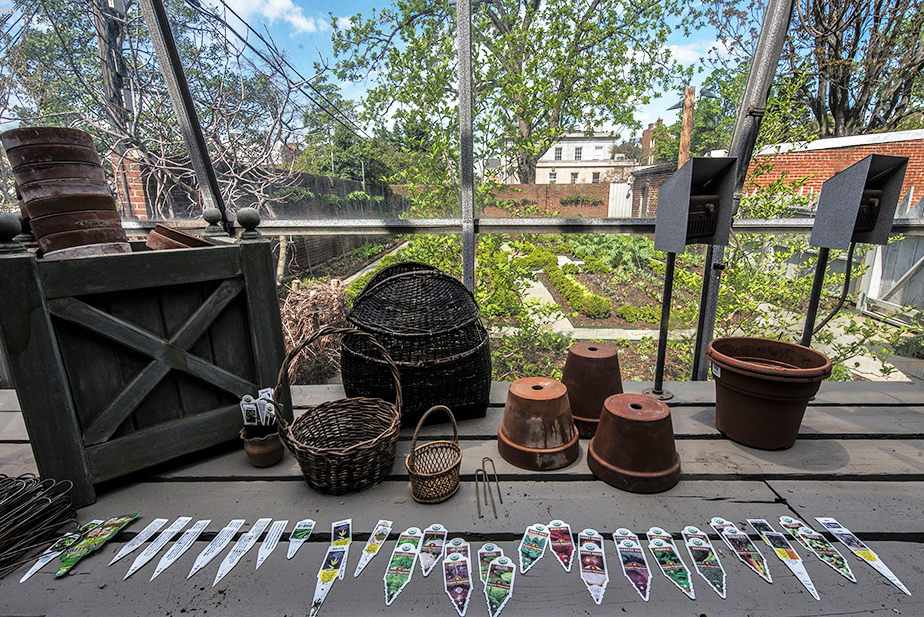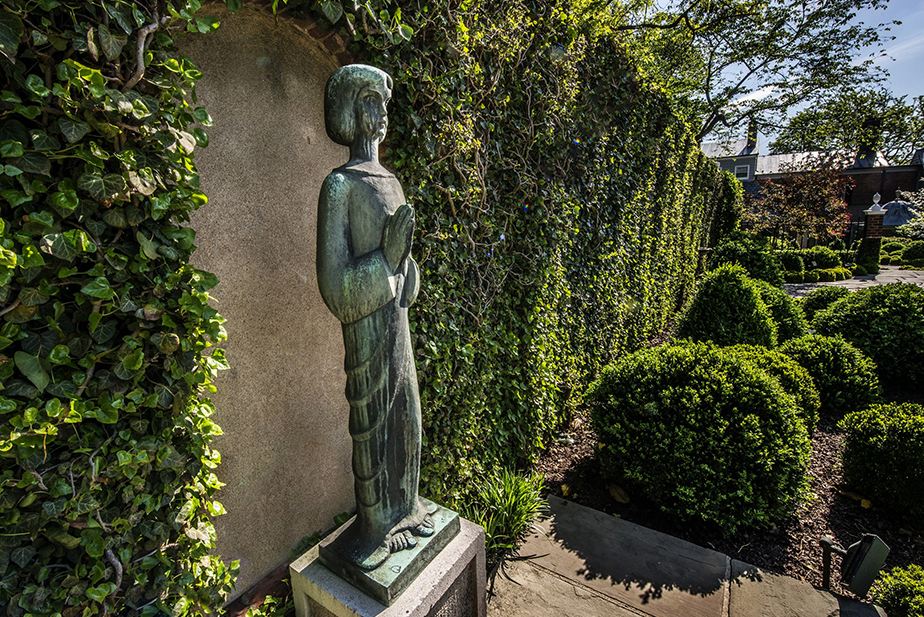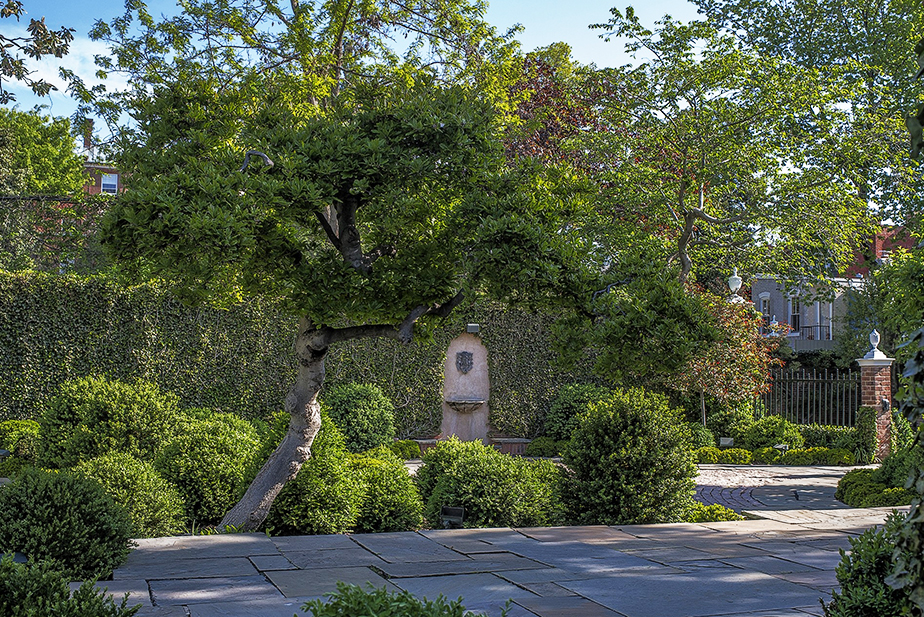 |
| Landscape Design | | | Boxwood | Planters | Antiques | | | Location | Events | Press | Bio | Contact |
WASHINGTON POST |
< previous | next > |
 |
 |
A Georgetown garden from the past finds new lifeBy Adrian Higgins, Published: May 7More than 20 years ago, I wrote a book about Georgetown gardens. Photographer Mick Hales took the pictures. We called it “The Secret Gardens of Georgetown,” which was a little cheeky because several of the 27 properties were essentially public. Even so, the landscapes of Dumbarton Oaks, Tudor Place and Oak Hill Cemetery remain veiled in the sense that they do not reveal themselves all at once. But one of the residential gardens in particular hit the book’s “secret” conceit perfectly: The garden of Nancy Gray was both private and one that unfurled in ways that could not be anticipated. A journey through it takes the visitor up a series of formal terraced gardens and past a number of outbuildings that include a library, two greenhouses and a freestanding theater. It culminates in a decorative walled vegetable garden that is especially dear to my heart, for reasons that will be explained. The genteel expanse of the garden would impress in any setting; that it occupies a large area in the heart of Georgetown gives it a fizz I find amazing. You can judge for yourself on Saturday, when it is open as part of the 86th Georgetown Garden Tour. The garden had been assembled over the course of a century or more, but it was given its character in the 1930s as one of the major Washington projects of a pioneering landscape architect named Rose Greely. Greely brought an Arts and Crafts sense of detail and craftsmanship to the prevailing Colonial Revival style of her time, and the Gray garden was a masterpiece of spatial arrangement in a contained urban environment. The main terrace is a walled garden perched above the house. Its most animated feature, a geometric fountain, is aligned with both the rear entrance of the house and, at right angles to it, a rectangular lawn framed by a path and boxwood plantings. In most Georgetown gardens, this terrace alone would suffice. The red brick walls are capped with classical white urns that function as eye-grabbing finials. Greely got the proportions just right: The terrace is large enough to allow the house to breathe but small enough to retain its inherent intimacy. The verdancy of the lawn and boxwood lend an air of tranquillity to the space. You feel the pleasant tension of being in the city but removed from it as well. As pleasing as it is, the main terrace accounts for perhaps a quarter of the property. It leads through a gate to an upper garden that functions as its own formal garden of shrubs and small trees, as well as an entrance for the theater, known as the playhouse, and the larger greenhouse (and potting shed). The upper garden is also a place of paths. One leads to a parking lot at the end of an alley. Another passes a long boxwood walk that leads past a fenced swimming pool, which was once an ornamental garden and, later, a tennis court. All this was described in the book, but we didn’t mention or photograph the vegetable garden. Bounded by more brick walls and by the back of the garage and a cedar fence, it may have been used to raise a few tomato plants but was essentially weedy, undefined and unused. The space, 60 feet by 30 feet, also contained the second greenhouse built by Nancy Gray’s husband, Gordon Gray, who was a passionate orchid grower. He died in 1982. Soon after the Grays came to the property in the late 1950s, they asked another prominent landscape architect, Perry Wheeler, to refine and update some of the features in the main and upper terraces. Bill O'Leary Washington Post WLandscape designer Aaron Deadman, left, and Nancy Pyne. A decade ago, long after the Georgetown book had come and gone, I was looking for a space to develop as a vegetable garden that I could use to grow fruit, veggies and herbs. It would be a place to cultivate edible plants — but also one I could write about, photograph and even use as a stage for videos. I remembered the secluded and underused corner of the Georgetown garden, and Nancy Gray, to her great credit, agreed to let me play in it. I wanted to show that a vegetable garden could be handsome as well as fruitful. I laid out and then built a series of flagstone paths and raised growing beds. The idea was to create a garden that was proportional, functional and in keeping with the formal and axial character of the greater garden. As part of the transformation, I suggested two other improvements: removing a volunteer magnolia tree that had grown mature and was shading the garden (the leaf drop was incessant from June on) and moving the gate in the wooden fence, which had been placed originally over a large drain. By this time, Nancy Gray had remarried and had become Nancy Pyne. I spent many pleasant hours in the garden. The distant noise and bustle of Georgetown were part of the aural fabric of the experience, but the space was so secluded and cosseting that the outside world melted away. Unfortunately, I had to move on: Efforts to find video collaborators came to naught, and my day job here at The Post expanded. The experience would have been one of life’s milestones, except that one day last fall, Pyne called me out of the blue. “I’ve had the garden completely restored. Come and have a look.” On a mild but drizzly day in early December, she showed me a revitalized main terrace garden, a place I knew had been in decline even back in the early 1990s. Now it was replete with unspeakably healthy-looking boxwood varieties of different size and leaf textures. The upper garden, too, had been revitalized with fresh broadleaf evergreens, including the double border of boxwood. The vegetable garden looked pretty good, too; I had forgotten how well the paths had turned out and forgotten even the back spasms that had come from setting each thick large flagstone on a bed of aggregate. Woven willow fences had been added in front of the greenhouse, and a fig tree I put in as a sapling had grown fat. A blackberry patch I planted was gone, but the walls were now cloaked in young espaliered apple and pear trees. It looked great, to be honest. I knew that newly restored formal boxwood gardens offered little indication of how much work was required to bring them back to health. Pyne spoke of massive soil excavation and applications of compost tea, but it wasn’t until later that I got the full story of the garden’s rebirth. Bill O'Leary Washington Post A duck strolls the lower terrace. In 2011 she hooked up with a New York-based firm, F2 Environmental Design, that specializes in high-end public and residential garden restorations using organic methods. F2’s Andrea Filippone is also a boxwood expert who is on a crusade to get people to move beyond the sickly standard English and American box varieties to embrace lesser-known hybrids that are elegant and agreeably pungent, but better garden plants. In the midst of their apple green flush, the Pyne garden boxwood are sparkling. In the upper garden, visitors will find an imposing, large-leafed variety named Rotundifolia. Elsewhere, a boxwood named Justin Brouwers gives the effect of mature English box, while a dwarf mounding type named Grace Hendrick Phillips evokes younger English box or, perhaps, a favorite of classy old gardens named Kingsville Dwarf. Eric T. Fleisher is the organic guru in the firm, who believes that the basis of all successful gardening is an understanding and nurturing of the soil biosphere. Healthy soil is rich in beneficial bacteria and fungi, some of which work directly with plant roots to nourish and protect their symbionts. Some of these microbes are eaten by tiny creatures that release nitrogen as they feed, Fleisher explained. It is a system that relies on good soil structure, lots of choice compost incorporated into the earth and the absence of chemical fertilizers and pesticides. When Filippone and Fleisher arrived in Georgetown, they found the main terrace garden in steep decline: Over the years, the clay soil had become so compacted that replacement boxwood had simply been planted on the ground rather than in it. Some of the beds were 18 inches or more above where they started out, and the soil had lost its ability to drain, never mind sustain a thriving microbial population. Boxwood perish in wet soil. “The more we got into it, the more it was like an archaeological dig,” Filippone said. They lifted and saved the English boxwood that could be kept, to be replanted in a more sheltered spot. New drainpipes were laid in excavated beds, which were then backfilled with a fresh soil mix of Fleisher’s design. (He examined microscopically 10 different compost mixes before selecting the one that met his standard.) Their crew hand-dug about 30 cubic yards of old soil, hauled away one pickup truck load at a time through the narrow back alley. In the upper garden, the boxwood that survived was so overgrown that you could barely use the paths. Early in the restoration, Fleisher and Filippone recruited a young, skilled gardener named Aaron Deadman, who has been maintaining the plantings with his crew in recent years. Together, they have been using remedial pruning to undo the topiary effects of sheared crab apples, magnolias and a specimen of Japanese maple in the main terrace. And the vegetable garden? The bones I had laid were still there, but the beds were inevitably lost to weeds. The greenhouse needed some repair. The beds were restored and edged with boxwood. With the promise of Saturday’s tour, we banded together in recent weeks to polish the vegetable garden for its rare public appearance. In late winter, I sowed lots of fava beans, peas and chard that have all developed nicely. Moreover, the four of us assembled and planted dozens of transplants of spring vegetables and herbs that Filippone selected for their color and beauty. Bill O'Leary Washington Post A view of the walled vegetable garden. The visitor will find artfully arranged rows of purple bok choy, mustard greens and red cabbages, with the green and chartreuse hues of various lettuces, spinach and chard. Cardoons erupt in silvery explosions. Deadman has been nurturing them through the long, cold spring. The espaliered fruit trees have bloomed successfully and have started their journey of fruiting. The garden’s central bed is marked by an antique Japanese ceramic rooster, with a creature on its back. As the rest of us were planting veggies, Fleisher was brewing his compost tea in large plastic barrels. The resulting microbial soup was sprayed over the plantings. The burgeoning spring vegetable garden has suddenly, unexpectedly fulfilled my old ambitions for it, forged new partnerships and become a symbol of the larger landscape’s rebirth. Apart from the personal attachment to the vegetable garden, I find it fascinating that what was a period piece has been transformed through modern soil science and plant selection into something young and vital without changing its fundamental character. In 1992, I thought I had stepped into the past. Twenty-two years on, I can see the same garden belongs to the future. Georgetown Garden Tour: The Pyne garden is one of nine private gardens on this year’s Georgetown Garden Tour. Saturday’s event has been a spring fixture in Washington for decades and offers a rare glimpse into the wonderful paradox of the Georgetown garden: As part of a historic district, the public faces of its homes follow strict architectural parameters. But the gardens, tucked away from view, are each different. They are shaped by the creative and horticultural skills and tastes of their owners, designers and gardeners. Many are in narrow, linear spaces. The need for screening and privacy is great. Meeting these requirements often proves both interesting and inspiring. All of the gardens are within walking distance of one another, and most of them are clustered east of Wisconsin Avenue NW. They include the Townsend garden on P Street, an elegant and architectural garden by veteran Georgetown designers DCA Landscape Architects that features parterres (decoratively shaped plant beds) and espaliers (trees trained on walls). Another on P Street, the Roll garden, is described by tour organizers as “a just about perfect small Georgetown garden” behind its 1810 house. Visitors will also find the expansive hillside garden of The Washington Post’s Ben Bradlee and Sally Quinn behind their 1794 Federal house on N Street. The tour is organized by the Georgetown Garden Club and will be held, rain or shine, from 10 a.m. to 5 p.m. Tickets cost $35 and are available at tour headquarters at Christ Church, at 31st and O streets NW. Proceeds are used for beautification projects. For more information, see the tour’s Web site at www.georgetowngardentour.com. |
 |
| < previous | next > |